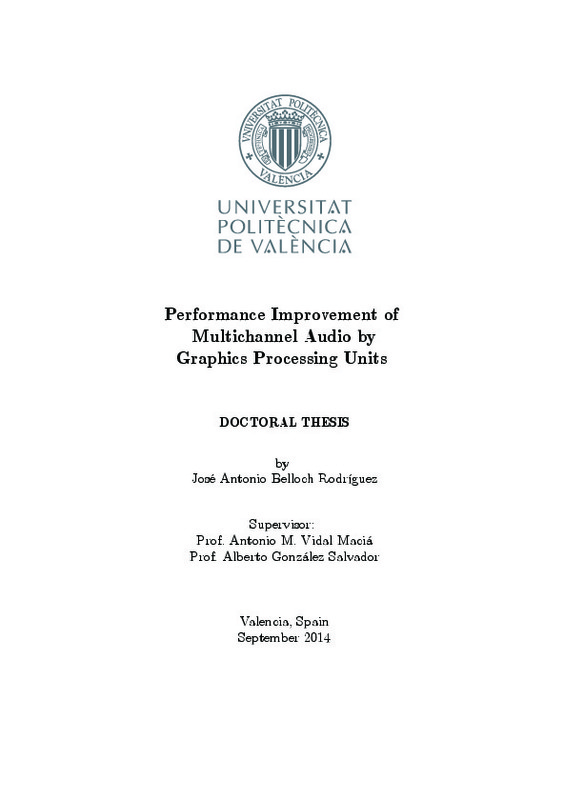|
Resumen:
|
Multichannel acoustic signal processing has undergone major development
in recent years due to the increased complexity of current audio processing
applications. People want to collaborate through communication with ...[+]
Multichannel acoustic signal processing has undergone major development
in recent years due to the increased complexity of current audio processing
applications. People want to collaborate through communication with the
feeling of being together and sharing the same environment, what is considered
as Immersive Audio Schemes. In this phenomenon, several acoustic
e ects are involved: 3D spatial sound, room compensation, crosstalk cancelation,
sound source localization, among others. However, high computing
capacity is required to achieve any of these e ects in a real large-scale system,
what represents a considerable limitation for real-time applications.
The increase of the computational capacity has been historically linked
to the number of transistors in a chip. However, nowadays the improvements
in the computational capacity are mainly given by increasing the
number of processing units, i.e expanding parallelism in computing. This
is the case of the Graphics Processing Units (GPUs), that own now thousands
of computing cores. GPUs were traditionally related to graphic or image
applications, but new releases in the GPU programming environments,
CUDA or OpenCL, allowed that most applications were computationally
accelerated in elds beyond graphics. This thesis aims to demonstrate
that GPUs are totally valid tools to carry out audio applications that require
high computational resources. To this end, di erent applications in
the eld of audio processing are studied and performed using GPUs. This
manuscript also analyzes and solves possible limitations in each GPU-based
implementation both from the acoustic point of view as from the computational
point of view. In this document, we have addressed the following
problems:
Most of audio applications are based on massive ltering. Thus, the
rst implementation to undertake is a fundamental operation in the audio
processing: the convolution. It has been rst developed as a computational
kernel and afterwards used for an application that combines multiples convolutions
concurrently: generalized crosstalk cancellation and equalization.
The proposed implementation can successfully manage two di erent and
common situations: size of bu ers that are much larger than the size of the
lters and size of bu ers that are much smaller than the size of the lters.
Two spatial audio applications that use the GPU as a co-processor have been developed from the massive multichannel ltering. First application
deals with binaural audio. Its main feature is that this application is able
to synthesize sound sources in spatial positions that are not included in the
database of HRTF and to generate smoothly movements of sound sources.
Both features were designed after di erent tests (objective and subjective).
The performance regarding number of sound source that could be rendered
in real time was assessed on GPUs with di erent GPU architectures. A
similar performance is measured in a Wave Field Synthesis system (second
spatial audio application) that is composed of 96 loudspeakers. The proposed
GPU-based implementation is able to reduce the room e ects during
the sound source rendering.
A well-known approach for sound source localization in noisy and reverberant
environments is also addressed on a multi-GPU system. This
is the case of the Steered Response Power with Phase Transform (SRPPHAT)
algorithm. Since localization accuracy can be improved by using
high-resolution spatial grids and a high number of microphones, accurate
acoustic localization systems require high computational power. The solutions
implemented in this thesis are evaluated both from localization and
from computational performance points of view, taking into account different
acoustic environments, and always from a real-time implementation
perspective.
Finally, This manuscript addresses also massive multichannel ltering
when the lters present an In nite Impulse Response (IIR). Two cases are
analyzed in this manuscript: 1) IIR lters composed of multiple secondorder
sections, and 2) IIR lters that presents an allpass response. Both
cases are used to develop and accelerate two di erent applications: 1) to
execute multiple Equalizations in a WFS system, and 2) to reduce the
dynamic range in an audio signal.
[-]
|














